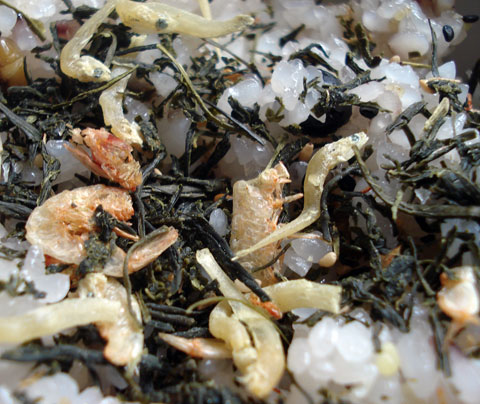Homemade furikake no. 9: Green tea

We used to have a neighbor lady in Japan who came from Shizuoka, a major tea growing region. She used to say that at her parents' house they used to eat tea leaves sprinkled with salt as a snack. At the time, the cynical kid that was me thought that sounded disgusting! But then I was recently surfing around some Japanese sites and stumbled upon the home page of a tea producer, who mentioned the same thing. They also said that they enjoyed tea as furikake.
The site didn't have a recipe, but they mentioned putting in chirimenjako (tiny salted fish, which I used in the hijiki seaweed furikake) and sakuraebi (tiny dried shrimp), used in Furikake no. 1, radish leaves.) Both are dried or semi-dried products that are packed with umami, and are also high in calcium. You can get them at any Japanese grocery store, and very similar products are available at general Asian or Chinese stores too. In case you can't get a hold of them though, I've given some variations below, including a vegan one.
The tea furikake definitely has the taste and fragrance of tea (with a hint of bitterness), enhanced by the umami of the other ingredients. It's really very pleasant. Tea furikake is not available commercially as far as I know (at least not outside of Japan). And if drinking the extract of tea leaves is so healthy, surely eating tea leaves has to be as good, if not better!
Recipe: Green tea furikake with chirimenjako and sakuraebi
- 1/3 cup (about 75 ml) fine green tea leaves (the better the quality of the tea, the more fragrant it will be)
- 2 Tbs. chirimenjako
- 2 Tbs. sakuraebi
- 1 1/2 tsp. good tasting sea salt
- 1/3 cup water
- 1 Tbs. sesame seeds (optional)
Heat up a non-stick frying pan. Add the water, salt, chirimenjako and sakuraebi, and stir until the salt is completely dissolved. Add the tea leaves. Over a low heat, keep stirring until moisture has completely evaporated, and the tea leaves are crispy (but not burnt!) It takes a little patience, but don't try to hurry things up by increasing the heat, or the tea leaves will burn and lose their fragrance. If salt gets stuck to the pan, scrape it off gently. Add the sesame seeds at the end and stir around to toast them.
Let cool completely and store in an airtight container. (If your tea leaves are a bit coarse, or you want a finer powder, whirl it in the food processor briefly.)
Variations
- For a simple vegan tea furikake, just use the best quality sea salt you have and omit the tiny fish and shrimp. You'll have the pure taste of tea and salt, plus sesame seeds if you add them. You can also try adding yeast flakes if you like the flavor, for added nutrition - about 1 Tbs. near the end of the cooking process. (You may need to experiment with the amount, so that the yeast doesn't overwhelm the tea.)
- You can use a handful of katsuobushi (bonito flakes) instead of the tiny fish and shrimp, or instead of one or the other. In this case, cook the tea leaves, salt and water on their own until the tea leaves are crispy, then add the bonito flakes at the end and stir it through.
Cooking with green tea furikake
If you cook the tea furikake with rice, it turns into tea takikomi gohan (rice that's cooked with various ingredients added). Add 1 tablespoon of furikake per 1 rice cooker cup of rice to the rice cooker with the water and washed rice. (if you're making your rice in a pot, allow for about 1 1/4 tablespoons per 220ml cup of rice.)

The rice is wonderfully fragrant. For a double dose of tea, top the tea takikomi gohan with more tea furikake!
If you enjoyed this article, please consider supporting this site by becoming my patron via Patreon.
